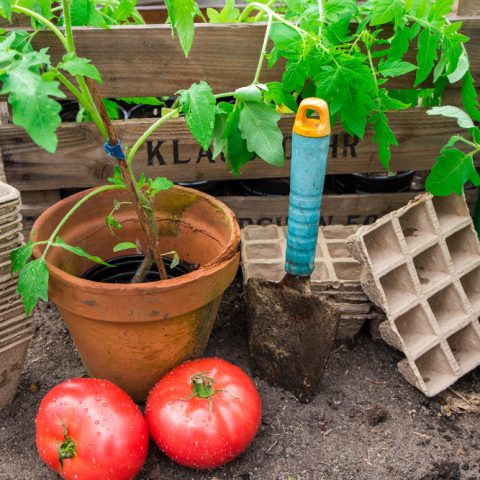We’ve never met a gardener who didn’t grow tomatoes. But tomato plant diseases can not only leave scars on tomatoes… it can leave scars on the fond memories and efforts of even the most diligent gardeners.
There is nothing like picking your own vine-ripened tomatoes to give you a sense of accomplishment as a gardener. Bursting with flavor and available in hundreds of hybrid and heirloom tomato varieties, this extremely versatile fruit is the most favorite “vegetable” to grow, even on balconies and in pots.
Catch it Early
It’s easy to get disheartened, when spots start appearing on your tomatoes, or the leaves start yellowing. It’s like a sick child… you want to help but feel helpless to know what to do. But don’t worry. There are things you can do to help, and things you can learn to prevent future damage.
There are several diseases and fungal attacks that can cause a set back in the ripening of those beloved tomatoes. It’s best to catch these early, so that you can maximize your harvest and enjoy these vitamin-packed globes right through the season.
First up, we will take a look at three common tomato plant diseases that are easily preventable from day one, simply through careful preparation and planning.
You know the saying… “An ounce of prevention is worth a pound of cure.”
TOMATO PLANT DISEASE PREVENTION
#1 – Phosphorus Deficiency Symptoms
- Veins of leaves turning purple
Tomatoes need a good supply of phosphorous to grow, and while most healthy soils should have plenty, it isn’t bio-available to the plants at low temperatures. Too little phosphorous can kill your plants and leave you without that bumper crop.
How to Avoid Phosphorous Deficiency
Don’t plant your tomatoes too early. What that means exactly, will depend on your climate. The soil needs to be warm when you plant your tomatoes. Cold soil reduces your plant’s absorption of phosphorous. You can also use mulch to warm the soil around your plants.
We also use a laser thermometer to keep a close watch on the temps in our straw bale garden.

#2 – Catfacing
Catfacing, is an odd term that refers to holes and scars at the blossom end of the fruit that basically make for an ugly tomato. In some instances, the puckering and indentations can look a bit like the shape of a cat’s face, thus the term.
Catfacing Symptoms in Tomatoes
- Puckering
- Cracks
- Indentation
What Causes Catfacing on Tomatoes?
- Cold weather
- Too fast growth and rain
- Dry period followed by heavy rain
- Wide ranging temperatures
- High levels of nitrogen
- Herbicides
The various causes of catfacing are thought to include disturbances to the flowers or flower buds during their development. Cold weather during blossoming, too-high nitrogen levels and contact with certain herbicides can all affect tomato blossoms and thus the tomato formation.
Larger tomato varieties are more susceptible to ‘catfacing’ than smaller ones.
~GardensAll.com

How to Avoid Catfacing
Don’t plant your tomatoes too early in the season or expose them to cold weather. If you live in an area with a short planting season, consider germinating seedlings and primary growth in a mini-greenhouse to help keep them warm.
Also, certain varieties of tomato are more prone to catfacing than others, so if you keep seeing this, try different varieties.
Tomatoes Resistant to Catfacing
- Duke
- CountII
- Floradade
- Walter[1]https://vric.ucdavis.edu/veg_info/catface.htm
A similar problem that afflicts even more tomatoes, are growth cracks which we cover next.
#3 – Tomato Cracks and Splits
This is just what it sounds like – cracks on tomatoes that run from the stem end and that can encircle the whole fruit.
Beyond being unsightly, tomato cracks can get invaded by bacteria, fungi or ants once they appear, all of which can ruin the fruit.
Growth cracks are the result of very rapid growth of the fruit, brought on by environmental conditions like abundant rain following a drought.
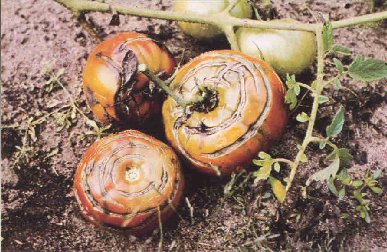
SOURCE: Image from Vegetable Research and Information Center VRIC, University of California Cooperative Extension: [2]https://vric.ucdavis.edu/veg_info/catface.htm
How to Avoid Growth Cracks on Tomatoes
- Even and consistent watering
- Mulch for moisture retention
Some tomato varieties, such as beefsteak, are more prone to growth cracks. Some varieties are less likely to crack because they have more elastic and resilient skin. (Ha!… I could use some of that!)
Crack Resistant Tomato Varieties Include
- Daybreak
- Early Girl
- Earl of Edgecombe
- Heinz 1350
- Jet Star
- Juliet tomatoes (cherry tomatoes)
- Mountain Delight
- Mountain Pride
- Valley Girl
See more here on what causes split tomatoes in this article.
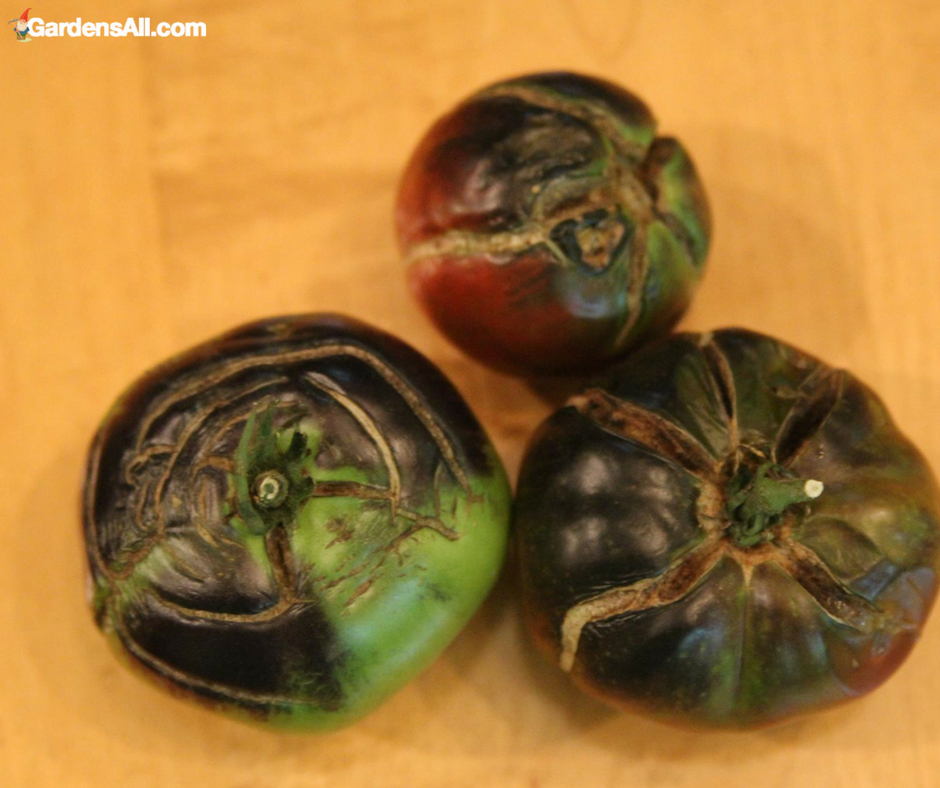
#4: Blossom Drop
With this issue, flowers appear on your tomato plants, but they fall off without tomatoes developing.
This can be caused by excessive temperature fluctuations. Tomatoes need night-time temperatures between 55 and 75 degrees Fahrenheit to keep their blossoms. Too high or too low, and the flowers drop off. It can also be caused by insect damage, lack of water, too much or too little nitrogen, and lack of pollination.
How to Avoid Blossom Drop
While you can’t change the weather, you can try to plant tomatoes in a protected area, such as a greenhouse when temperatures drop. Make sure the plant is strong by using organic fertilizer, drawing pollinators by planting milkweed and cosmos, and using neem oil insecticides.
- Protect tomato seedlings from the cold
- Include pollinator plants such as milkweed and cosmos
- Fertilize with a quality organic fertilizer or compost
- Neem oil insecticides help

#5 – Poor Fruit Set
Symptoms of Poor Tomato Fruit Setting
- Fewer flowers, even less tomatoes
- Tomatoes small and tasteless
- Nice green leaves
Causes of Poor Tomato Fruit Production
- Too much nitrogen
- Plants too close together
You have some flowers but not many tomatoes. The tomatoes you do have on the plant are small or tasteless. Fertilizing is great, but too much nitrogen in the soil encourages plenty of green leaves but not many flowers. If your plant doesn’t have enough flowers, there won’t be enough tomatoes.
Another cause may be planting tomatoes too closely together. Tomatoes are self-pollinating, meaning that each flower contains both the male (stamens) and female (pistils) parts. Wind typically pollinates tomatoes, but if plants are too close together, the wind can’t reach the flowers.
How to Avoid Poor Tomato Production
- Have your soil tested and don’t over-fertilize, especially with nitrogen-rich fertilizer.
- Leave at least two feet or more between plants so that good air circulation can help pollinate them.
- Improve pollination by hand shaking the flowering branches to simulate wind and get the pollen from the stamens to the pistils of the tomato blossoms.
TOMATO PLANT DISEASES:
~GardensAll.com
Too much nitrogen can cause healthy green leaves but few flowers and fruit.
#6: Leaf Curl, AKA, Leafroll
Mature tomato plants suddenly curl their leaves, especially older leaves near the bottom. Leaves roll up from the outside towards the center. Sometimes up to three-quarters of the plant can be affected. High temperatures, wet soil and too much pruning tomato plants can also cause leafroll.
Causes of Leaf Curl
- High temperatures
- Wet soil
- Wind damage
- Herbicide
- Broad mite
- Viruses
- Too much pruning
Although it looks ugly, a little bit of leaf roll won’t affect tomato development, and you will still get edible tomatoes.
Avoid over pruning tomato plants and make sure the soil drains excess water away. However, if the cause of the damage isn’t removed, the leaf curl can ruin your harvest.[3]https://aggie-horticulture.tamu.edu/vegetable/files/2010/10/E-626-What-Makes-Tomato-Leaves-Twist-or-Curl.pdf
The Good News About Leafroll:
~GardensAll.com
Curled leaves on tomato plants may not look pretty but they shouldn’t affect your harvest unless the cause persists or increases.
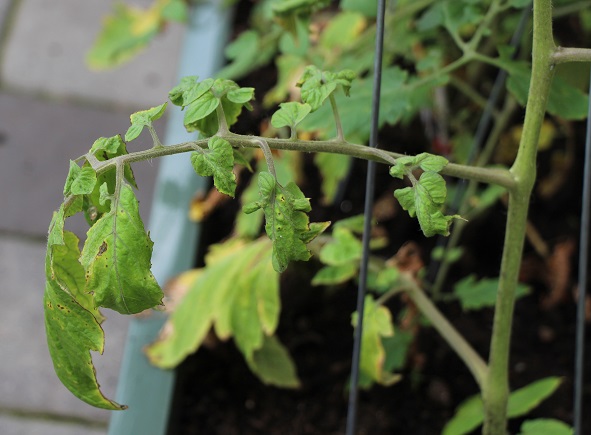
#7: Early Blight
Early blight is caused by a fungus called Alternaria solani.
If you find brown spots on tomato leaves, starting with the older ones, keep an eye out.
With tomato blight, each spot starts to develop rings, like a target. Leaves turn yellow around the brown spots, then the entire leaf turns brown and falls off. Eventually the plant may have few, if any, leaves.
Symptoms of Early Blight
- Brown spots on leaves that develop rings around them
- Leaves turn yellow around the brown spots
- Entire leaf turns brown and falls off
Causes of Early Blight
This fungus can live in the soil over the winter, so if you get this problem one season, planting tomatoes in the same area the next season may result in an unwanted deja vu experience.
How to Avoid Early Blight
- Buy starts and seeds from reliable sources.
- Plant with enough space between plants for air circulation.
- Add a layer of mulch or use the red plastic tomato mulch to create a barrier between tomato foliage and soil.
- Check plants frequently during extreme wet or dry weather and try to mitigate these stressors.
- Alternate spraying organic copper spray, and Serenade biological fungicide the moment you notice possible signs of blight.*
- Keep garden area cleaned of plant debris and clean it up promptly at the end of the growing season.
- Rotate crops and plant nightshades in new areas.
- Try growing in plant containers and planters.
* Use copper carefully to avoid toxic buildup in the soil.
Treat infected plants with a fungicide, and make sure you’re practicing good crop rotation. Don’t plant tomatoes or related plants, such as potatoes, peppers or eggplants, in the same soil, or you could lose these crops.
See more on how to grow the best tomatoes.
Are Early Blight Tomatoes Edible?
Naturally, people want to know, if blight affected tomatoes are edible. This is one of those “it depends”, kind of answers.
Of course, we’d not wish to ever steer anyone in the wrong direction so the caveat is—as always—to use good judgement. So here’s the general consensus from our research toward helping you decide for yourself.
With Early Tomato Blight, if the plant is infected, but the fruit bears no signs of it, experts agree that it’s okay to eat it. However, best not to use these tomatoes for canning.
The fruit may be carrying blight spores without showing outward signs. Any lesions on the tomato can be cut out and the rest of it washed and eaten. If you are uncertain as to the quality of any fruit, just follow the old adage, “If in doubt, toss it out”.
BLIGHT WASH FOR TOMATOES
To be safe, wash each tomato with soap and water or mix up a quick-dip in a 10% bleach solution (9 parts water to 1 of bleach) followed by a good washing. You can also use hydrogen peroxide instead of bleach.[4]https://clearandwell.com/diy-fruit-vegetable-wash-remove-dirt-bacteria-pesticides/
Fruit and Veggie Wash with Bleach
- 9 parts water
- 1 part bleach
You can also find ready
EARLY BLIGHT:
~GardensAll.com
You can eat unaffected tomatoes, but if in doubt, toss it out.
Also know that plants can be infected with early blight, but not yet showing signs. If you get sick from eating any fruit, even if the plant doesn’t show any, there may be other pathogens there which could potentially cause illness. Once again, better safe than sorry.
If a plant looks like it is being compromised by a disease but many unripened fruit still cling to the vine and appear fine, you can try picking and allow them to ripen on their own.
These will need a good washing as well since they could be harboring spores. In spite of your attempt to rescue, the disease can still prevail and proceed to rot out your salvaged crop.
Find more info and images on early tomato blight here.
#8. Anthracnose
This is a tough one, for there are no resistant varieties and it’s very hard to get rid of. Our yellow “Dad’s Sunset” tomatoes were afflicted this season.
The bottom line is that it’s a fungus that is soil or seed borne and once it sets in, there’s not much to do for it organically, but plant tomato crops in new areas where the soil may not be contaminated.
You can see an example of an anthracnose fungus infected tomato in the image below..
Managing anthracnose includes avoiding growing tomatoes and other nightshade plants in the same affected area for as long as three to four years!
For more in depth information on the anthracnose fungus, visit this article on the Cornell University Agricultural blog.
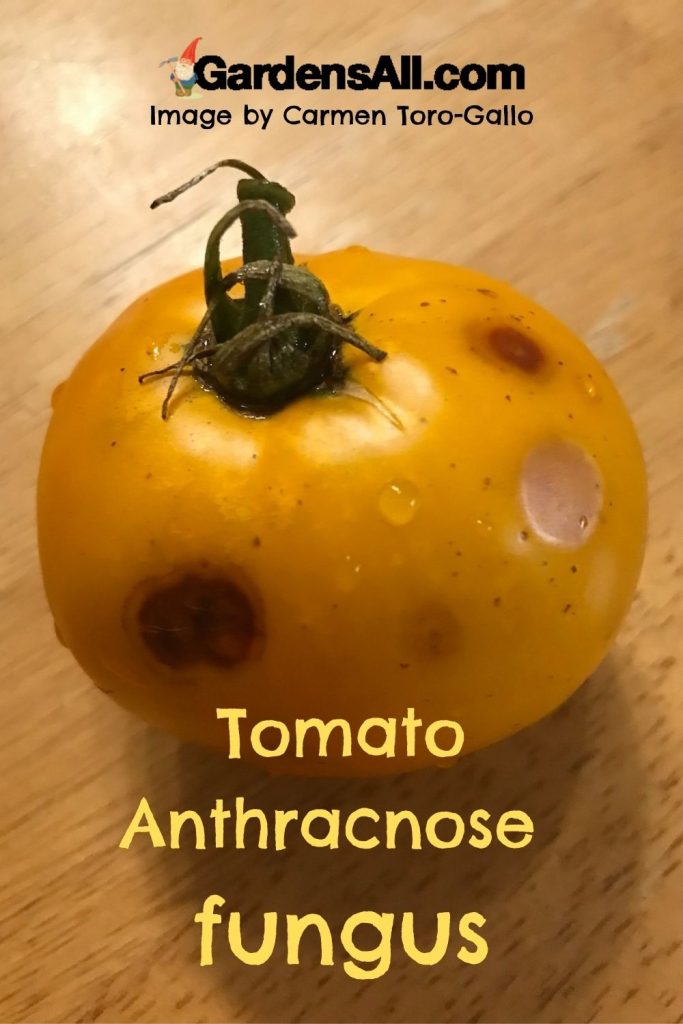
We’d love to hear your experience. You can reach us via email or post your comments on the GardensAll Facebook page.

Wishing you great gardens and happy harvests!
We are an online gardening publication sharing all things garden related! Including urban farming, family gardening, homesteading, gardening for profits, and more. We’re all about growth!
References

